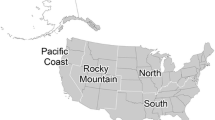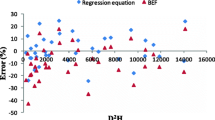Abstract
Indirect approaches to estimation of biomass factors are often applied to measure carbon flux in the forestry sector. An assumption underlying a country-level carbon stock estimate is the representativeness of these factors. Although intensive studies have been conducted to quantify biomass factors, each study typically covers a limited geographic area. The goal of this study was to employ a meta-analysis approach to develop regional biomass factors for Quercus mongolica forests in South Korea. The biomass factors of interest were biomass conversion and expansion factor (BCEF), biomass expansion factor (BEF) and root-to-shoot ratio (RSR). Our objectives were to select probability density functions (PDFs) that best fitted the three biomass factors and to quantify their means and uncertainties. A total of 12 scientific publications were selected as data sources based on a set of criteria. From these publications we chose 52 study sites spread out across South Korea. The statistical model for the meta-analysis was a multilevel model with publication (data source) as the nesting factor specified under the Bayesian framework. Gamma, Log-normal and Weibull PDFs were evaluated. The Log-normal PDF yielded the best quantitative and qualitative fit for the three biomass factors. However, a poor fit of the PDF to the long right tail of observed BEF and RSR distributions was apparent. The median posterior estimates for means and 95 % credible intervals for BCEF, BEF and RSR across all 12 publications were 1.016 (0.800–1.299), 1.414 (1.304–1.560) and 0.260 (0.200–0.335), respectively. The Log-normal PDF proved useful for estimating carbon stock of Q. mongolica forests on a regional scale and for uncertainty analysis based on Monte Carlo simulation.




Similar content being viewed by others
References
Borenstein M, Hedges LV, Higgins JPT, Rothstein HR (2009) Introduction to meta-analysis. Wiley, Chichester
Brooks S, Gelman A (1998) General methods for monitoring convergence of iterative simulations. J Comput Graph Stat 7:434–456
Brown S (2002) Measuring carbon in forests: current status and future challenges. Environ Pollut 116:363–372
Brown S, Lugo AE (1982) The storage and production of organic matter in tropical forests and their role in global carbon cycle. Biotropica 14:161–187
Cannell MGR (1982) World forest biomass and primary production data. Academic Press, London
Congdon P (2006) Bayesian statistical modelling. Wiley, Chichester
Falk M, Hüsler J, Reiss R-D (2010) Laws of small numbers: extremes and rare events. Springer, Basel
Fang J-Y, Wang ZM (2001) Forest biomass estimation at regional and global levels, with special reference to China’s forest biomass. Ecol Res 16:587–592
Gelman A, Hill J (2007) Data analysis using regression and multilevel/hierarchical models. Cambridge University Press, Cambridge
Hartung J, Knapp G, Sinha BK (2008) Statistical meta-analysis with applications. Wiley, Hoboken
Hedges LV (1994) Fixed effects models. In: Cooper H, Hedges LV (eds) The handbook of research synthesis. Russell Sage Foundation, New York, pp 285–301
IPCC (2006a) IPCC guidelines for national greenhouse gas inventories: volume 1 general guidance and reporting. In: Eggleston S, Buendi L, Miwa K, Ngara T, Tanab K (eds), Intergovernmental Panel on Climate Change (IPCC) IPCC/IGES Hayama
IPCC (2006b) IPCC guidelines for national greenhouse gas inventories: volume 4 agriculture, forestry and other land use. In: Eggleston S, Buendia L, Miwa K, Ngara T, Tanabe K (eds), Intergovernmental Panel on Climate Change (IPCC) IPCC/IGES Hayama
Jalkanen A, Mäkipää R, Ståhl G, Lehtonen A, Petersson H (2005) Estimation of the biomass stock of trees in Sweden: comparison of biomass equations and age-dependent biomass expansion factors. Ann For Sci 65:845–851
Jenkins JC, Chojnacky DC, Heath LS, Birdsey RA (2003) National-scale biomass estimators for United States tree species. For Sci 49:12–35
KFRI (2010) Study on the basis of forest carbon accounting in Korea. Korea Forest Service, Seoul
Korea Forest Service (2009) Stem volume table. Korea Forest Service, Seoul
Kwon K-C, Lee DK (2006a) Biomass and annual net production of Quercus mongolica stands in Mt. Joongwang with respect to altitude and aspect. J Korean For Soc 95:398–404
Kwon K-C, Lee DK (2006b) Biomass and energy content of Quercus mongolica stands in Gwangyang and Jeju areas. J Korean Wood Sci Soc 34:54–65
Kwon K-C, Lee DK (2006c) Above- and below-ground biomass and energy content of Quercus mongolica. J Korean For Energ Soc 25:31–38
Lee DK, Kwon K-C (2006) Biomass and annual net production of Quercus mongolica stands in Pyungchang and Jecheon areas. J Korean For Soc 95:309–315
Lee KJ, Park IH (1987) Primary production and nutrients distribution in 22-year-old Pinus koraiensis and Quercus mongolica stands in Kwangju district. J Korean For Energy Soc 7:11–21
Levy PE, Hale SE, Nicoll BC (2004) Biomass expansion factors and root:shoot ratios for coniferous tree species in Great Britain. Forestry 77:421–430
Li X, Yi MJ, Son Y, Jin G, Lee KH, Son YM, Kim RH (2010) Allometry, biomass and productivity of Quercus forests in Korea: a literature-based review. J Korean For Soc 99:726–735
Li R, Stewart B, Weiskittel A (2012) A Bayesian approach for modelling non-linear longitudinal/hierarchical data with random effects in forestry. Forestry 85:17–25
Lunn DJ, Thomas A, Best N, Spiegelhalter D (2000) WinBUGS—a Bayesian modelling framework: concepts, structure, and extensibility. Stat Comput 10:325–337
McLachlan G, Peel D (2000) Finite mixture models. Wiley-Interscience, New York
Metropolis N, Rosenbluth AW, Rosenbluth MN, Teller AH, Teller E (1953) Equation of state calculations by fast computing machines. J Chem Phys 21:1087–1092
Návar J (2010) Measurement and assessment methods of forest aboveground biomass: a literature review and the challenges ahead. In: Momba M, Bux F (eds) biomass. Croatia, Sciyo, pp 27–64
Ntzoufras I (2009) Bayesian modeling using WinBUGS. Wiley, Hoboken
Park G-S (2003) Biomass and net primary production of Quercus mongolica stands in Kwangyang, Pyungchang, and Youngdong areas. J Korean For Soc 92:567–574
Park IH, Moon GS (1994) Biomass, net production and biomass estimation equations in some natural Quercus forests. J Korean For Soc 83:246–253
Park IH, Lee DK, Lee KJ, Moon GS (1996) Growth, biomass and net production of Quercus species (I). J Korean For Soc 85:76–83
Park I-H, Kim D-Y, Son Y-H, Yi M-J, Jin H-O, Choi Y-H (2005a) Biomass and net production of a natural Quercus mongolica forest in Namsan, Seoul. Korean J Environ Ecol 19:299–304
Park IH, Son Y, Kim DY, Jin HO, Yi MJ, Kim RH, Hwang JO (2005b) Biomass and production of a naturally regenerated oak forest in southern Korea. Ecol Res 20:227–231
Picard N, Henry M, Mortier F, Trotta C, Saint-André L (2012) Using Bayesian model averaging to predict tree aboveground biomass in tropical moist forests. For Sci 58:15–23
Schroeder P, Brown S, Mo J, Birdsey R, Cieszewski C (1997) Biomass estimation for temperate broadleaf forests of the United States using inventory data. For Sci 43:424–434
Somogyi A, Cienciala E, Mäkipää R, Muukkonen P, Lehtonen A, Weiss P (2007) Indirect methods of large-scale forest biomass estimation. Eur J For Res 126:197–207
Son Y, Kim DY, Park IH, Yi MJ, Jin HO (2007) Production and nutrient cycling of oak forests in Korea: a case study of Quercus mongolica and Q. variabilis stands. Kangwon National University Press, Chuncheon
Song CY, Lee SW (1996) Biomass and net primary productivity in natural forests of Quercus mongolica and Quercus variabilis. J Korean For Soc 85:443–452
Spiegelhalter DJ, Best NG, Carlin BP, van der Linde A (2002) Bayesian measures of model complexity and fit. J R Stat Soc Ser B 64:583–640
Teobaldelli M, Somogyi Z, Migliavacca M, Usoltsev VA (2009) Generalized functions of biomass expansion factors for conifers and broadleaved by stand age, growing stock and site index. For Ecol Manag 257:1004–1013
Usoltsev VA (2001) Forest biomass of northern Eurasia: database and geography. Russian Academy of Sciences, Ural Branch Yekarinenburg
Van Camp N, Walle IV, Mertens J et al (2004) Inventory-based carbon stock of Flemish forests: a comparison of European biomass expansion factors. Ann For Sci 61:677–682
Wirth C, Schumacher J, Schulze E-D (2004) Generic biomass functions for Norway spruce in Central Europe—a meta-analysis approach toward prediction and uncertainty estimation. Tree Physiol 24:121–139
Zhang X, Duan A, Dong L, Cao QV, Zhang J (2014) The application of Bayesian model averaging in compatibility of stand basal area for even-aged plantations in southern china. For Sci 60:645–651
Acknowledgements
We would like to express our sincere thanks to Jeong-seon Kim for assistance in translating the Korean literature. We also thank Korea Forest Research Institute for the funding to conduct this research, and the many researchers who have conducted the studies used for the meta-analysis. Lastly, we would like to express sincere thanks to the anonymous reviewers for comments and suggestions that have greatly improve the publication.
Author information
Authors and Affiliations
Corresponding author
Additional information
Project fund: This study was supported by Korea Forest Research Institute.
The online version is available at http://www.springerlink.com
Corresponding editor: Chai Ruihai
Electronic supplementary material
Below is the link to the electronic supplementary material.
Rights and permissions
About this article
Cite this article
Lam, T.Y., Li, X., Kim, R.H. et al. Bayesian meta-analysis of regional biomass factors for Quercus mongolica forests in South Korea. J. For. Res. 26, 875–885 (2015). https://doi.org/10.1007/s11676-015-0089-x
Received:
Accepted:
Published:
Issue Date:
DOI: https://doi.org/10.1007/s11676-015-0089-x




